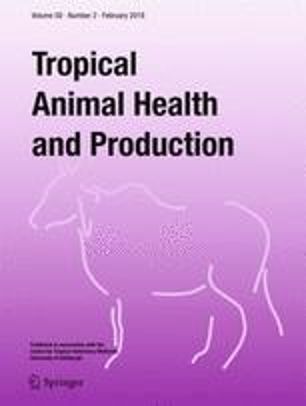Ver ítem
- xmlui.general.dspace_homeCentros e Institutos de InvestigaciónCIAP. Centro de Investigaciones AgropecuariasInstituto de Investigación Animal del Chaco SemiáridoArtículos científicosxmlui.ArtifactBrowser.ItemViewer.trail
- Inicio
- Centros e Institutos de Investigación
- CIAP. Centro de Investigaciones Agropecuarias
- Instituto de Investigación Animal del Chaco Semiárido
- Artículos científicos
- Ver ítem
Detection and first molecular characterization of bovine papular stomatitis virus in dairy calves in Argentina
Resumen
Bovine papular stomatitis virus (BPSV) is a parapoxvirus associated with papular and erosive lesions on the muzzle, lips, and oral mucosa of cattle. BPSV infection occurs worldwide; however, it has still not been unequivocally diagnosed. The present report describes an outbreak of BPSV infection affecting dairy calves in northwestern Argentina and provides the first molecular characterization of this virus in the country. The disease was detected in a
[ver mas...]
Bovine papular stomatitis virus (BPSV) is a parapoxvirus associated with papular and erosive lesions on the muzzle, lips, and oral mucosa of cattle. BPSV infection occurs worldwide; however, it has still not been unequivocally diagnosed. The present report describes an outbreak of BPSV infection affecting dairy calves in northwestern Argentina and provides the first molecular characterization of this virus in the country. The disease was detected in a dairy farm, affecting 33 calves between 2 and 20 days of age. The signs included reddish papules, ulcers, and scabby proliferative lesions on muzzle, lips, and oral mucosa. The affected calves resisted to being fed due to severe local pain. Two necropsies were performed; papulas and ulcers were observed in ruminal and omasal mucosa. Histologically, the affected areas of the skin showed acanthosis, spongiosis, and parakeratotic hyperkeratosis with adjacent focally extensive ulcers and multifocal inflammatory infiltrate in the epidermis. Eosinophilic inclusion bodies were detected in the cytoplasm of epithelial cells. DNA extracted from scab samples was analyzed by PCR using pan-parapoxvirus primers for the B2L gene. The sequence analysis revealed 99%, 85%, and 84% similarity with BPSV, Pseudocowpox virus, and Orf virus, respectively. A phylogenetic tree constructed using the B2L sequence showed that the virus clustered with BPSV isolates. Although clinical cases compatible with BSPV infection have been frequently described in Argentina, the present report is the first to identify the agent associated with cattle disease in the country.
[Cerrar]

Autor
Micheloud, Juan Francisco;
Aguirre, Laura S.;
Sandoval, Gabriela V.;
Avellaneda-Cáceres, Agustín;
Diodati, Julian Angel;
Peralta, Andrea Veronica;
Fuente
Tropical animal health and production : 1–7. (29 July 2019)
Fecha
2019
Editorial
Springer
ISSN
0049-4747
1573-7438 (Online)
1573-7438 (Online)
Formato
pdf
Tipo de documento
artículo
Palabras Claves
Derechos de acceso
Restringido
 Excepto donde se diga explicitamente, este item se publica bajo la siguiente descripción: Creative Commons Attribution-NonCommercial-ShareAlike 2.5 Unported (CC BY-NC-SA 2.5)
Excepto donde se diga explicitamente, este item se publica bajo la siguiente descripción: Creative Commons Attribution-NonCommercial-ShareAlike 2.5 Unported (CC BY-NC-SA 2.5)

